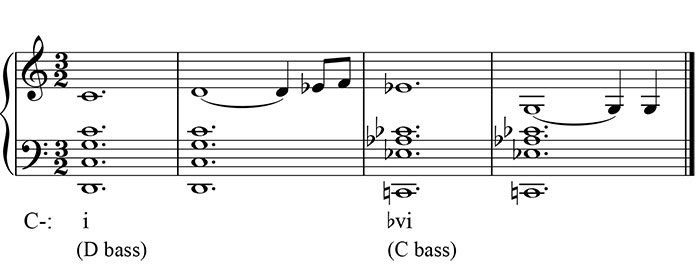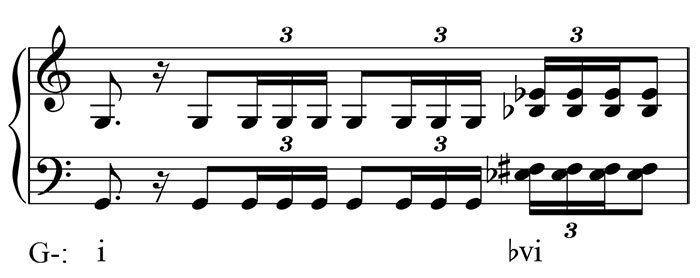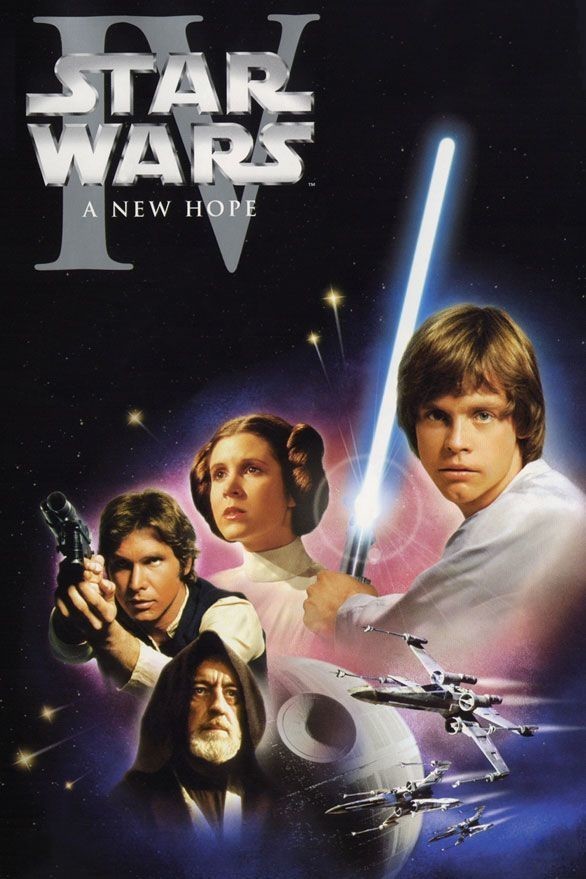Through the first six films of the Star Wars saga, John Williams’ inimitable scores have generated a large body of musical themes that have played an inextricable part in building the fantasy world that is the backbone of the films. As a way of both celebrating these scores and building up to an analysis of the score for the upcoming Episode VII, I begin here a series of six analyses that will run through each of the six films, each post featuring a single theme that is introduced in the film under discussion.
Star Wars (1977), the film that started it all, introduced a handful of themes, most of which recur in the Star Wars hexology of films. But the one theme that has appeared with the greatest frequency at over 100 statements is the Force theme. Because I have already posted about the musical structure of the Force theme, in the film music analysis that follows, I will focus on the theme’s meanings and usage throughout the six films.
Associations and Meanings
Pinning down one specific meaning for the Force theme is an elusive task since its association is much broader than the typical leitmotif. Although it is associated with the “good guys”, it does not have a single, consistent association, but instead can signify four interrelated concepts:
- Character – Obi-Wan / the Jedi
- The Force – or Becoming a Jedi
- Struggle – of the Jedi / Good Guys
- Victory – of the Jedi / Good Guys
The character function of the theme is most evident in the first film, sounding when Obi-Wan first reveals his face. Even the mention of his name in this scene prompts another statement, shown below (start at 3:16):
In other cases, the theme seems to represent characters who are either Jedi or who have Force powers and are potential future Jedi. This is especially clear in scenes where the theme accompanies a character who already has another theme. Such scenes include the binary sunset in Star Wars, where Luke yearns to join the Academy but does not yet know that he will soon begin to be trained as a Jedi; Leia in The Empire Strikes Back, who hears Luke’s call for help by means of the Force; Yoda in Revenge of the Sith, who decides to journey to the Wookiee’s home planet to help them fend off the droid army; the boy Anakin in The Phantom Menace, who is forced to leave his mother behind in order to be trained as a Jedi; and even Darth Vader in Return of the Jedi, who reclaims his good, Jedi side by killing the Emperor and saving Luke’s life. This latter scene is shown in the clip below (the Force theme entering at 1:12):
But perhaps the Force theme’s most prominent usage is in connection with the Force itself and the path to becoming a Jedi. Luke’s discussions with Obi-Wan and Yoda on the nature of the Force in Star Wars and The Empire Strikes Back are usually accompanied by the theme. Likewise, in The Phantom Menace, the theme is heard with Qui-Gon’s warning to the boy Anakin that a Jedi’s life is a hard one. In a similar way, the theme tends to surface when the Force is used to get the good guys out of trouble. Hear it, for example, in Star Wars just after Obi-Wan uses the “mind trick” on stormtroopers at Mos-Eisley in order to pass through the checkpoint (theme at 3:45):
The struggle of the Jedi or the good guys in general is another aspect of the Force theme’s meaning. This explains the statements at such moments as Luke in Star Wars being warned that fighters are approaching his X-wing from behind, or Lando in The Empire Strikes Back promising Leia they will find Han, or Anakin and Obi-Wan in Revenge of the Sith steering their ship as it begins to disintegrate in a planet’s atmosphere.
Finally, the Force theme sometimes serves no other purpose but to accompany the good guys’ victory. This kind of association occurs most famously in the award ceremony scene that ends Star Wars, but also occurs in The Phantom Menace when the boy Anakin manages to destroy a Federation ship from its inside, deactivating the droid army on the planet surface.
These various meanings of the Force theme are far from being entirely distinct. After all, almost every statement of the theme accompanies one of the Jedi in some way, and, as I have shown in a previous post, the struggle aspect is built into the Force theme’s musical structure, guaranteeing at least some of this feeling with each of its statements. Thus, even with the great flexibility in the theme’s associations, it nevertheless always retains some aspect of the “Jedi struggle” with nearly every one of its iterations.
Complete and Foregrounded Statements
In the vast majority of its statements, the Force theme is heard in a truncated form, with only its first half or less being sounded. But on occasion, it appears in its full two-phrase form (especially with its climactic third idea), and those complete statements that are prominently featured, or foregrounded, are particularly worthy of attention. This is true whether or not the theme actually reaches a promised final chord or breaks off during its final idea. In Star Wars, complete, foreground statements occur with the binary sunset and award ceremony scenes mentioned earlier. In Return of the Jedi, another such statement sounds when Luke lights Vader’s funeral pyre. These statements from the original trilogy of films all accompany moments that serve as markers of significant turning points in the Rebellion’s struggle against the Empire. This trend continues in the prequel trilogy, as a complete, foregrounded version of the theme is heard in The Phantom Menace when the boy Anakin destroys the Federation ship mentioned earlier, when Anakin leaves Padme while on Tatooine to search for his missing mother, and when Luke’s adoptive parents first hold him as a baby as they watch the binary sunset, paralleling the first film’s binary sunset scene:
Notably, there is no full and foregrounded statement of the Force theme in either The Empire Strikes Back, almost certainly because this film occupies the central position in its trilogy and hence, marking neither the saga’s beginning nor its end, offers no real turning points in the larger narrative. Instead, Empire and its score are much more concerned with developing the relationship between Han and Leia, and with introducing the new character of Yoda. These shifts away from the core narrative of the saga leave far less room for statements of the Force theme, complete and foregrounded or not. Indeed, Empire contains the fewest number of Force theme statements of all the films in the original trilogy.
In Attack of the Clones, we hear a full, foregrounded version of the theme just as Anakin is on his way to search for his mother. This pivotal moment in the film marks the beginning of Anakin’s descent into evil, as he ends up slaughtering the entire camp of Sand People who were holding his mother hostage, including the women and children. View the scene below (up to 0:43):
Revenge of the Sith brings four complete, foregrounded statements of the Force theme, more than any other prequel film. The first of these accompanies Obi-Wan and Anakin in the battle with the Federation that opens the film, the second scores their ship’s perilous descent into a planet’s atmosphere, and the third highlights Obi-Wan’s journey to the planet Utupau, where he will face General Grievous. Of course, none of these moments are pivotal turning points in the narrative, but they do focus on either Obi-Wan or the partnership of Anakin and Obi-Wan, both of which are central to the film’s narrative since Anakin will break this partnership by turning to the Dark Side and Obi-Wan will duel with him in the film’s, and the trilogy’s, narrative climax. As though foreshadowing this ultimate outcome of the “Jedi struggle”, the first full and foregrounded statement of the Force theme is the first theme we hear in the film proper after the opening narrative crawl, shown in the clip below. Notice how the two small ships we see, which we soon discover are Anakin’s and Obi-Wan’s, move in near-perfect synch with each other, subtly suggesting the closeness of the friendship and hence the great toll that Anakin’s later defection has on both Obi-Wan and the Jedi as a whole:
Harmonic Alterations
Although the supporting harmony of Force theme remains fairly consistent in the original trilogy, the prequel films introduce two striking new alterations. In Revenge of the Sith, roughly one third of the theme’s statements alter the final chord of the first half from a major IV chord to the bII, or Neapolitan, chord. Compare these two renditions of the theme below (second version transposed to G minor for ease of comparison):


As I mention in my previous analysis of the Force theme, because the IV chord would usually be minor in a minor key (in which the Force theme is set), the alteration to a major IV is something like a beacon of hope within the Rebels’ struggle, mainly because it involves the raising of scale degree 6 a semitone up from what it would normally be. But closing the first half with the bII chord involves the lowering of scale degree 2, which now casts a dark pall over the theme and signals an emotional tone that is much more pessimistic. It is no surprise, then, to find that this version of the Force theme permeates Revenge of the Sith. Indeed, it is even heard in the film’s first statement in the clip above (from 0:30-0:34), adding a greater sense of foreboding to the film than the original version of the theme would have. Naturally, the two statements of the theme in the final duel between Obi-Wan and Anakin/Vader involve this gloomier harmonization. The first of these is heard below at 2:36 (the Neapolitan entering at 2:46):
Significantly, this version of the theme is actually introduced in The Phantom Menace, first when Qui-Gon tells Anakin that the Jedi’s life is a hard one, then when Anakin leaves his mother, not looking back, as she requested. Hear this latter statement below at 54:21:
Hence, this darker version of the theme is associated with the suggestion of Anakin becoming a Jedi, and with his leaving his mother behind, both of which prove to be crucial to Anakin’s transformation into Darth Vader.
There is, however, a subtler alteration to the theme that is heard with its second appearance in the “Battle of the Heroes” music of the final duel. At this point in the film, Obi-Wan tells his one-time apprentice that “I have failed you, Anakin,” since Anakin has now joined the Sith and become Darth Vader. Notably, the first idea heard in the Force theme takes on a new harmony on at its end instead of merely continuing the same chord throughout the idea. Hear it below from 6:15-6:31:
Aside from the gritty dissonance of the bass notes (a typical Star Wars “ism”), the two chords in this first idea are the minor tonic, i, and the minor flat submediant, bvi. These are precisely the same two chords that open the Imperial March, or Darth Vader’s theme. Compare the two below:
Altered Force Theme

Vader’s Theme – Opening Riff

This allusion to Vader within the Force theme not only suggests that the “Jedi struggle” now includes contending with Darth Vader, but also that Anakin’s good, Jedi side has been contorted into his twisted, evil side that has become Vader. In short, this alteration creates a subtle but effective musical parallel for the situation onscreen.
Conclusion
The Force theme is one of the Star Wars saga’s most iconic themes. Indeed, the flexibility of its associations renders it an ideal leitmotif for scoring multiple trilogies, where it can be applied to a wide variety of characters, situations, and concepts without fundamentally altering its meanings. And with its number of statements across the first six films surpassing that of even Luke’s theme (101 to 84, by my count), the Force theme could well be thought of as the saga’s “other” main theme.
Coming soon… Uses of Vader’s Theme

Hi Mark,
I am glad you decided to start this series about the Star Wars themes. You always bring out harmonic subtleties I have not realized before.
I look forward to your next posts in this topic, and especially to your analysis of the score for the upcoming Episode VII. Actually, I am far more interested in the music of the upcoming film than its plot and visuals.
Hi Mark,
Wonderful! I can’t wait to read the next 5 installments. I think your point about the Force Theme as being, effectively, the second “Main Theme” is absolutely spot on, especially in the prequels. I wonder if things will play out similarly in Ep VII.
I also find your observations about different patterns of usage in the interior films fascinating. Though I’m not sure about there being absolutely no full or foregrounded versions; IIRC there’s a handful of fullish statements in ESB during the Dagobah scenes, and a soft but still foregrounded version at the beginning of the “Rebel Fleet” sequence. And in AOTC, there’s a huge rendition right before the DOTF passage, which precedes a pivotal moment in the narrative (and is stated in G-min, no less!).
Thanks for your enthusiasm for these posts, Frank. The point I make about the full statements is that they are both complete and foregrounded, so the big statement in Attack of the Clones is not quite the same as the others because it is left without its closing idea. You may feel this is splitting hairs somewhat, but I find it interesting that the full and foregrounded statements are reserved for the moments that are the biggest landmarks in the narrative. And although the Dagobah scenes do have full statements as you indicate, all have dialogue overtop of the theme, so I don’t place them in the same category because our attention is not primarily on the music. Now which is the Rebel fleet sequence you mention?
Not hair-splitting at all, I now see exactly what you mean about real (PAC-driven) thematic completion, and understand how important that is formally (Though I do think the AOTC reference does still mark a narrative turning point.) The Rebel Fleet version is right at the end of the movie, with a little dialogue over the first half, and a more major “B-phrase” after the HC. Curiously, this similar to how the (probably not Williams) piano arrangement of the Force Theme behaves!
After our further private correspondence, I now agree that the statement in Attack of the Clones counts as a full, foregrounded statement as well. This really is the first time Anakin carries out an evil act in killing the entire lot of Sand People and thereby begins his descent towards the Dark Side. Each of these major turning points also seems highlighted with a memorable image as well. In Binary Sunset, it’s obviously the strangeness of having two suns. In this scene, it’s the shadows of Anakin and Padme on the side of the farm home as Anakin tells Padme to stay there. In any case, I’ve updated the post to reflect this new point of view. Thanks, Frank!
Hey Mark,
Glad you’re doing these. I was reminded of your blog while writing a paper for a Film Studies class (unfortunately, not taught by Aaron Taylor). I’m glad you discussed the usage of the Force theme in Revenge of the Sith, specifically the moment in which Anakin and Obi-Wan have their hands together while trying to use the Force on one another (At 1:45 in your Neapolitan chord example). This is a moment that has stood out to me for quite some time as an exemplary use of the theme, and something I’ve personally thought about discussing in some sort of written format.
I look forward to reading the rest of your analyses as well as whatever you put together for The Force Awakens.